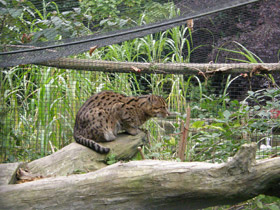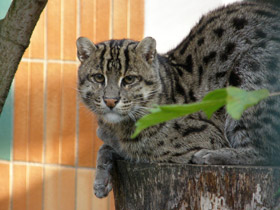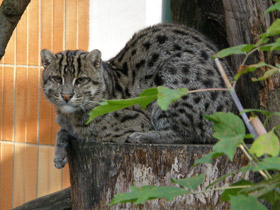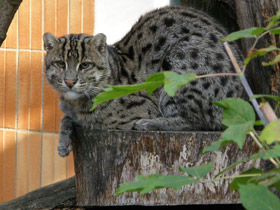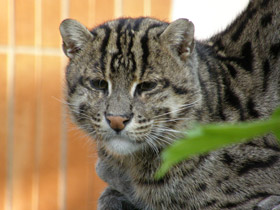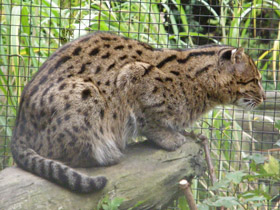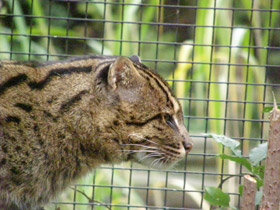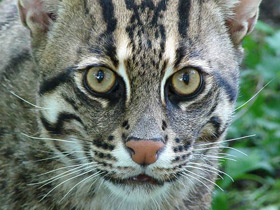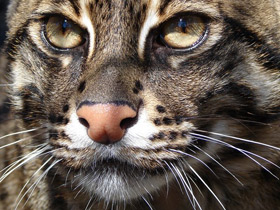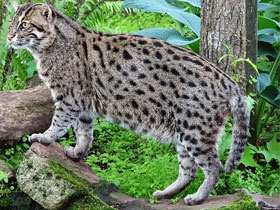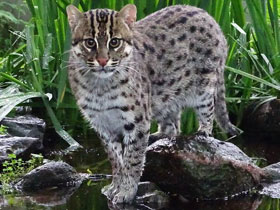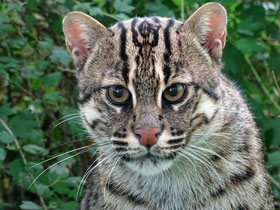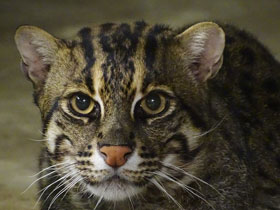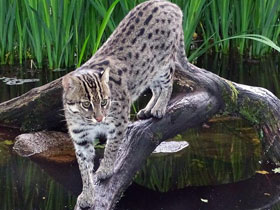The fishing cat (Prionailurus viverrinus)
 The fishing cat (Prionailurus viverrinus) is included in the IUCN Red List as a "vulnerable species"
The fishing cat (Prionailurus viverrinus) is included in the IUCN Red List as a "vulnerable species"
The fishing cat (Prionailurus viverrinus) is a medium-sized wild cat of South and Southeast Asia. Since 2016, it is listed as Vulnerable on the IUCN Red List. Fishing cat populations are threatened by destruction of wetlands and have declined severely over the last decade. The fishing cat lives foremost in the vicinity of wetlands, along rivers, streams, oxbow lakes, in swamps, and mangroves.
The fishing cat is the state animal of West Bengal.
Taxonomy
Felis viverrinus was proposed by Edward Turner Bennett in 1833 who described a fishing cat skin from India. Prionailurus was proposed by Nikolai Severtzov in 1858 as generic name for spotted wild cats native to Asia. Felis viverrinus rhizophoreus was proposed by Henri Jacob Victor Sody in 1936 who described a specimen from the north coast of West Java that had a slightly shorter skull than fishing cat specimens from Thailand. There is evidence that the nominate taxon and the Javan fishing cat are distinguishable by skull morphometrics.
Distribution
Prionailurus viverrinus is a widely distributed species of carnivorous mammal of the family Felidae native to Asia. There are two subspecies. It is sometimes classified within the genus Felis.
It is common in Sri Lanka, all along the coast of South and Southeast Asia as far as Malacca and Sumatra; smaller specimens live in Java and Bali. Prionailurus viverrinus is an inhabitant of rainforests at altitudes up to 1,500 metres and of mangrove swamps near rivers and streams.
Appearance
Prionailurus viverrinus has a strong, muscular body 95-120 cm long, short legs; large, rounded head with strong jaws. The neck of Prionailurus viverrinus is also short, the ears rounded, small, set low on the sides of the head; the tail is not long (26-36 cm) and thick at the base. Females of this predator are smaller than males and weigh only 6-7 kg (males can weigh 11-15 kg). The coat of Prionailurus viverrinus is short and coarse, olive-brown or olive-grey, which makes it almost invisible in thickets. Surprisingly, this cat has webbing on its forelegs between the toes, which prevents its large, sharp claws from retracting, but helps it to catch fish in the water.
Lifestyle and nutrition
Prionailurus viverrinus can also climb trees, but rarely does so. Most of the time it can be seen walking in shallow water. It swims well and uses its short tail as a rudder. Prionailurus viverrinus is a solitary animal, each individual having its own individual territory. As its name suggests, this predator's favourite food is fish. It catches fish during daylight hours, and may hunt other prey at dusk and at night. When fishing, Prionailurus viverrinus sits on the bank of a stream or river and waits, and as soon as it notices a fish, it kicks its prey hard with its claw. It also hunts toads, frogs, crustaceans, snakes, small mammals and birds, and sometimes even attacks poultry, dogs, goats and calves.
Reproduction
Prionailurus viverrinus breeds all year round. Females give birth to 2-3 blind kittens in a burrow, which they arrange in thickets of reeds or bushes, in natural caves or in hollow trees. The kittens' eyes open at 15 days, the mother feeds them with milk until they are 3 months old and then begins to feed them with meat. Kittens mature at 9 months of age. Male Prionailurus viverrinus in captivity assist the mother in caring for the young, but it is not known exactly how they behave in the wild.
Threats
The fishing cat is threatened by destruction of wetlands, which are increasingly being polluted and converted for agricultural use and human settlements. The conversion of mangrove forests to commercial aquaculture ponds is a major threat in Andhra Pradesh, where the targeted killing of fishing cats is also prevalent where there is human/animal conflict. Over-exploitation of local fish stocks and retaliatory killing are also significant threats. In West Bengal's Howrah district, 27 dead fishing cats were recorded between April 2010 and May 2011. In Bangladesh, at least 30 fishing cats were killed by local people in three years between January 2010 and March 2013. Furthermore, in a study in Thailand, 84% of all fishing cats that were tracked via radio collars were killed – either due to poaching or unknown causes.
The fishing cat is possibly extinct in coastal Kerala, India.
Conservation
Prionailurus viverrinus is included on CITES Appendix II, and protected by national legislation over most of its range. Hunting is prohibited in Bangladesh, Cambodia, China, India, Indonesia, Myanmar, Nepal, Pakistan, Sri Lanka, Thailand. Hunting regulations apply in Lao PDR. In Bhutan and Vietnam, the species is not protected outside protected areas. Its survival depends on protection of wetlands, prevention of indiscriminate trapping, snaring and poisoning.
In areas where habitat degradation is a major concern, such as coastal Andhra Pradesh, NGOs are working to slow habitat conversion in collaboration with local villagers. Part of this work involves creating alternative livelihood programs that allow villagers to earn money without damaging natural habitats.
In captivity
Fishing cat captive breeding programmes have been established by the European Association of Zoos and Aquaria and the American Association of Zoos and Aquariums. All the fishing cats kept in zoos around the world are listed in the International Studbook of the World Association of Zoos and Aquariums.
Subespecie
- Prionailurus viverrinus risophores;
- Prionailurus viverrinus viverrinus.

















